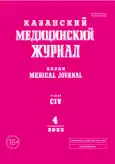Особенности местных и системных показателей при хронических ринитах
- Авторы: Гончарова Н.С.1, Смирнова О.В.1
-
Учреждения:
- Федеральный исследовательский центр «Красноярский научный центр» Сибирского отделения Российской академии наук
- Выпуск: Том 104, № 4 (2023)
- Страницы: 614-622
- Раздел: Обмен клиническим опытом
- Статья получена: 02.12.2022
- Статья одобрена: 28.06.2023
- Статья опубликована: 24.07.2023
- URL: https://kazanmedjournal.ru/kazanmedj/article/view/115032
- DOI: https://doi.org/10.17816/KMJ115032
- ID: 115032
Цитировать
Полный текст
Аннотация
Цель. Изучение особенностей местных и системных показателей при хронических ринитах.
Материал и методы исследования. В группы обследования были включены 21 пациент с хроническим аллергическим ринитом, 20 пациентов с хроническим вазомоторным ринитом, 9 пациентов с хроническим атрофическим ринитом, 15 больных хроническим инфекционным ринитом и 50 человек из группы контроля. Диагностика хронического ринита в зависимости от фенотипа осуществлена с учётом клинических рекомендации Минздрава России врачом при обращении пациента за лечением, с последующим анализом данных полного комплекса инструментального обследования, клинических проявлений, анамнеза и результатов риноэндоскопии. 65 обследуемым с хроническими ринитами, а также группе контроля выполняли цитологическое исследование слизистой оболочки полости носа и оценку гематологических показателей. Статистический анализ проведён с использованием пакета Statistica 10. Для оценки различий в группах использовали непараметрические критерии Краскела–Уоллиса (для трёх и более групп сравнения) и Манна–Уитни (для попарного сравнения). Критический уровень статистической значимости при проверке научных гипотез составлял р ˂0,05.
Результаты. При хроническом аллергическом рините локально выявлено три синдрома: аллергический синдром (со статистически значимым увеличением абсолютного количества эозинофилов до 14 в поле зрения), синдром неспецифического воспаления (со статистически достоверным повышением количества лейкоцитов до 9 в поле зрения) и синдром защитных изменений слизистой оболочки носа. При этом в крови зафиксированы изменения, связанные с аллергическим синдром (со статистически достоверным увеличением абсолютного количества эозинофилов до 0,84×109/л). При хроническом вазомоторном рините изменения в слизистой оболочке носа не вызывали существенных изменений в активности клеток крови. При хроническом атрофическом рините дегенеративные изменения слизистой оболочки носа (при статистически достоверном снижении числа клеток эпителия до 2 в поле зрения; p1–4 <0,001, p2–4 <0,001) с локальным геморрагическим синдромом сопровождаются наличием статистически значимых анемического (гемоглобин до 109 г/л; p1–4 <0,001, p2–4 <0,001, p3–4 <0,001, p4–5 <0,001) и воспалительного синдромов по показателям крови (со статистически достоверным лейкоцитозом до 10×109/л; p1–4 <0,001, p2–4 <0,001, p3–4 <0,001). При хроническом инфекционном рините локальный воспалительный синдром со статистически значимым увеличением количества лейкоцитов до 75 в поле зрения (p1–5 <0,001, p2–5 <0,001, p3–5 <0,001, p4–5 <0,001) и защитными изменениями слизистой оболочки носа подтверждается системным воспалительным синдромом со статистически значимыми лейкоцитозом до 12×109/л (p1–5 <0,001, p2–5 <0,001, p3–5 <0,001, p4–5=0,04), нейтрофильным гранулоцитозом до 9×109/л (p1–5 <0,001, p2–5 <0,001, p3–5 <0,001, p4–5=0,03) и увеличением скорости оседания эритроцитов до 22 мм/ч (p1–5 <0,001, p2–5 <0,001, p3–5 <0,001, p4–5 <0,001) по анализам крови.
Вывод. Наибольшее количество локальных и системных изменений выявлено при хроническом аллергическом и хроническом инфекционном ринитах, что требует повышенного внимания к данным заболеваниям.
Полный текст
Об авторах
Наталья Сергеевна Гончарова
Федеральный исследовательский центр «Красноярский научный центр» Сибирского отделения Российской академии наук
Автор, ответственный за переписку.
Email: nzelenyk@gmail.com
ORCID iD: 0000-0003-3547-7813
мл. научн. сотрудник, аспирант, Научно-исследовательский институт медицинских проблем Севера
Россия, г. Красноярск, РоссияОльга Валентиновна Смирнова
Федеральный исследовательский центр «Красноярский научный центр» Сибирского отделения Российской академии наук
Email: ovsmirnova71@mail.ru
ORCID iD: 0000-0003-3992-9207
докт. мед. наук, проф., зав. лаб., лаб. клинической патофизиологии, Научно-исследовательский институт медицинских проблем Севера
Россия, г. Красноярск, РоссияСписок литературы
- Блоцкий А.А., Карпищенко С.А., Блоцкий Р.А. Сравнительный анализ эффективности хирургического лечения хронического ринита в амбулаторных условиях. Дальневосточный медицинский журнал. 2012;(4):82–85. EDN:PNCDVZ.
- Блоцкий А.А., Карпищенко С.А., Блоцкий Р.А. Лечение вазомоторного ринита высокоэнергетическим лазером в амбулаторных условиях. Тихоокеанский медицинский журнал. 2013;(3):79–80. EDN:SOCBOP.
- Крылова Т.А., Завалий М.А., Балабанцев А.Г. Дифференциальная диагностика аллергического и неаллергического хронического ринита. Практическая медицина. 2015;(2-2):13–18. EDN: UAASIN.
- Карпова Е.П., Бараташвили А.Д. Фенотипическая классификация ринитов и основные принципы терапии. РМЖ. Медицинское обозрение. 2019;3(8):33–36. EDN: QHKYWS.
- Wilson KF, Spector ME, Orlandi RR. Types of rhinitis. Otolaryngol Clin North Am. 2011;44(3):55–59. doi: 10.1016/j.otc.2011.03.016.
- Бодня О.С., Ненашева Н.М. Антигистаминные препараты 2-го поколения при аллергическом рините: опыт реальной клинической практики. Русский медицинский журнал. 2019;27(3):45–50. EDN:IZBUIZ.
- Лопатин А.С., Варвянская А.В. Вазомоторный ринит: патогенез, клиника, диагностика и возможности консервативного лечения. Практическая пульмонология. 2007;(2):33–38. EDN: OOZAYH.
- Wallace DV, Dykewicz MS, Kaliner MA. Classification of nonallergic rhinitis syndromes with a focus on vasomotor rhinitis, proposed to be known henceforth as nonallergic rhinopathy. World Allergy Organ J. 2009;2:98–101. doi: 10.1097/WOX.0b013e3181a9d55b.
- Морозов А.М., Сороковикова Т.В., Жуков С.В., Морозова А.Д., Рыжова Т.С., Муравлянцева М.М., Пичугова А.Н., Минакова Ю.Е. Актуальные маркёры воспаления в клинической практике. Современные проблемы науки и образования. 2022;(3):142. doi: 10.17513/spno.31653.
- Белякова Р.А. Риноцитограмма как метод диагностики аллергического ринита. Молодой учёный. 2017;(12):120–123. EDN: YHWWZJ.
- Коваленко Л.А., Суходолова Г.Н. Интегральные гематологические индексы и иммунологические показатели при острых отравлениях у детей. Общая реаниматология. 2013;9(5):24. doi: 10.15360/1813-9779-2013-5-24.
- Rondon C, Campo P, Togias A, Fokkens WJ, Durham SR, Powe DG, Mullol J, Blanca M. Local allergic rhinitis: concept, pathophysiology, and management. J Allergy Clin Immunol. 2012;129(6):1460–1467. doi: 10.1016/j.jaci.2012.02.032.
- Степанов Е.Н. Роль нарушения микроциркуляции слизистой оболочки полости носа в патогенезе различных форм хронического ринита. Практическая медицина. 2011;(3-1):11–14. EDN: NUSAKN.
- Garsia GJM, Bailie N, Martins DA. Atrophic rhinitis: a CFD study of air conditioning in the nasal cavity. J Appl Physiol. 2007;103(3):1082–1092. doi: 10.1152/japplphysiol.01118.2006.
- Парилова О.В., Капустина Т.А., Белова Е.В., Маркина А.Н. Эпидемиологические и иммунологические характеристики у взрослых лиц с хроническими воспалительными заболеваниями носа и околоносовых пазух, ассоциированных с хламидийной инфекцией. Российский иммунологический журнал. 2016;10(2):184–184. EDN: WNEUFF.
Дополнительные файлы






